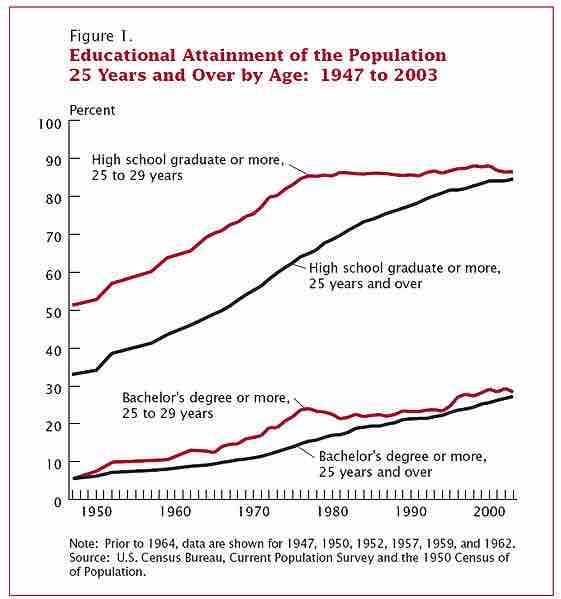Contemporary Education Issues
Major educational issues in the United States center on curriculum and control. One of the major controversies of the United States education policy is the No Child Left Behind Act which will be covered in its own section.
Curriculum issues
There is no unified curriculum in the United States. Not only do schools offer a range of topics and quality, but private schools may include mandatory religious classes. These religious aspects raise the question of government funding school vouchers in states with Blaine Amendments in their constitution. This has produced debate over the standardization of curricula. Additionally, there is debate over which subjects should receive the most focus, with astronomy and geography among those cited as not being taught enough in schools.
Attainment
Drop-out rates are a concern in American four year colleges. In New York, 54 percent of students entering four-year colleges in 1997 had a degree six years later — and even less among Hispanics and African-Americans. Since the 1980s the number of educated Americans has continued to grow, but at a slower rate. Some have attributed this to an increase in the foreign born portion of the workforce. However, the decreasing growth of the educational workforce has instead been primarily due to slowing down in educational attainment of people schooled in the United States .

Educational Attainment Since 1947
This graph shows the educational attainment from 1947 to 2003 in the United States.
Racial Achievement Gap
The Racial Achievement Gap in the United States refers to the educational disparities between minority students and Caucasian students. This disparity manifests itself in a variety of ways: African-American and Hispanic students are more likely to receive lower grades, score lower on standardized tests, drop out of high school, and are less likely to enter and complete college.
Evolution in Kansas
In 1999 the School Board of the state of Kansas caused controversy when it decided to eliminate teaching of evolution in its state assessment tests. Scientists from around the country demurred. Many religious and family values groups, on the other hand, claimed that evolution is simply a theory in the colloquial sense, and as such creationist ideas should therefore be taught alongside it as an alternative viewpoint. A majority of the Kansas population supported teaching intelligent design and/or creationism in public schools.
Sex education
Almost all students in the U.S. receive some form of sex education between grades 7 and 12; many schools begin addressing some topics as early as grades 4 or 5. However, what students learn varies widely, because curriculum decisions are so decentralized. Many states have laws governing what is taught in sex education classes or allowing parents to opt out. Some state laws leave curriculum decisions to individual school districts.
According to a 2004 survey, over 80% of polled parents agreed that the sex education was helpful while fewer than 17% stated their view that the sex education was inappropriate. 10 percent believed that their children's sexual education class forced them to discuss sexual issues "too early. "
Textbook review and adoption
In many localities in the United States, the curriculum taught in public schools is influenced by the textbooks used by the teachers. In some states, textbooks are selected for all students at the state level. Since states such as California and Texas represent a considerable market for textbook publishers, these states can exert influence over the content of the books.
In 2010, the Texas Board of Education adopted new Social Studies standards that could potentially impact the content of textbooks purchased in other parts of the country. The deliberations that resulted in the new standards were partisan in nature and are said to reflect a conservative leaning in the view of United States history.
Affirmative action
In 2003 a Supreme Court decision concerning affirmative action in universities allowed educational institutions to consider race as a factor in admitting students, but ruled that strict point systems are unconstitutional. Opponents of racial affirmative action argue that the program actually benefits middle- and upper-class people of color at the expense of the lower class. Prominent African American academics Henry Louis Gates and Lani Guinier, while favoring affirmative action, have argued that in practice, it has led to recent black immigrants and their children being greatly overrepresented at elite institutions, at the expense of the historic African American community made up of descendants of slaves.
Control
There is some debate about where control for education actually lies. Education is not mentioned in the constitution of the United States. In the current situation, the state and national governments have a power-sharing arrangement, with the states exercising most of the control. The federal government uses the threat of decreased funding to enforce laws pertaining to education. Furthermore, within each state there are different types of control. Some states have a statewide school system, while others delegate power to county, city or township-level school boards.